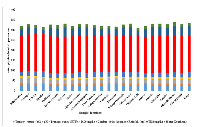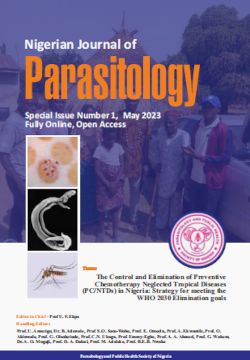Impacts of Water Physicochemical Parameters on Schistosomiasis Vector Snail Distributional-Abundance and Infectivity rate in South-Eastern Nigeria
DOI:
https://doi.org/10.4314/njpar.v45i1.17Keywords:
Schistosomiasis, Lanistesspp, Bulinusspp, physicochemical parameters, water analysisAbstract
Schistosomiasis, an NTD, poses public health problems for rural communities. The parameters controlling its intermediate hosts are scarcely studied. 24 human-water contacts were sampled for 12 months to understand the impacts of water parameters on the vector. Sampling was done by monthly handpicking of the snail vector with a net to analyze the water parameters (temperature, dissolved oxygen, conductivity, depth, and rainfall). 546 snails recovered from the water sites showed that Bulinus globosus had the highest occurrence (50.5%), followed by Lanistes varicus (27.7%), and Bulinus truncatus species (3.7%). Ohaukwu LGA recorded the highest occurrence of freshwater snails at 55.3%, while Amovu stream had the highest number of snails with an overall abundance of 35.9%. May had the highest cercariae shedding at 26%, followed by June at 20%. No shedding occurred in September, November, December, and January. The infectivity rate of freshwater snails collected showed a significant difference based on the month (X2=6590.079, p-value=0.006). The study reveals that water physicochemical parameters significantly influence the abundance of intermediate snail hosts, with all parameters positively correlated except for temperature, conductivity, and TDS. This poses a significant public health threat
due to vector snails' presence.
References
Mereta, S. T., Abaya, S. W., Tulu, F. D., Takele, K., Ahmednur, M., Melka, G. A., Nanyingi, M., Vineer, H. R., GrahamBrown, J., Caminade, C., and Mor, S. M. (2023). Effects of Land-Use and Environmental Factors on Snail Distribution and Trematode Infection in Ethiopia.Tropical Medicine and Infectious Disease, 8(3), 1–13. https://doi.org/10.3390/tropicalmed8030154
Grimes, J. E., Croll, D., Harrison, W. E., Utzinger, J., Freeman, M. C., and Templeton, M. R. (2015). The roles of water, sanitation and hygiene in reducing schistosomiasis: a review. Parasites & Vectors, 8(1), 156. https://doi.org/10.1186/s13071-015-0766-9
Costa-Pierce, B. A. (2022). The Anthropology of Aquaculture. Frontiers in Sustainable Food Systems, 6 .https://doi.org/10.3389/fsufs.2022.843743
Hailegebriel, T., Nibret, E., and Munshea, A. (2020). Prevalence of Schistosoma mansoni and S. haematobium in Snail Intermediate Hosts in Africa: A Systematic Review and Meta-analysis. Journal of Tropical Medicine, 2020, 1 – 18. https://doi.org/10.1155/2020/8850840
Thiam, F., Fall, C. B., Gaye, P. M., Senghor, B., Diamanka, A., Wotodjo, A. N., Abotsi, K., Parola, P., Faye, B., Sokhna, C., Sow, D., and Doucouré, S.
(2022). Study of the behaviour of snails intermediate hosts of Schistosoma spp. under different maintenance conditions and their resistance to salinity in an african laboratory environment. Heliyon, 8(8),e 1 0 2 8 9 .https://doi.org/10.1016/j.heliyon.2022.e10289
Kagabo, J., Kalinda, C., Nshimiyimana, P., Mbonigaba, J. B., Ruberanziza, E., Nyandwi, E., and Rujeni, N. (2023). Malacological Survey and Spatial
Distribution of Intermediate Host Snails in Schistosomiasis Endemic Districts of Rwanda. Tropical Medicine and Infectious Disease, 8(6), 295.
https://doi.org/10.3390/tropicalmed8060295
Deribew, K., Erko, B., Tiku Mereta, S., Yewhalaw, D., and Mekonnen, Z. (2022). Assessing Potential Intermediate Host Snails of Urogenital Schistosomiasis, Human Water Contact Behavior and Water Physico-chemical Characteristics in Alwero Dam Reservoir, Ethiopia. Environmental
Health Insights, 16, 117863022211235. https://doi.org/10.1177/1178630222112357
Tian-Bi, Y.-N. T., Webster, B., Konan, C. K., Allan, F., Diakité, N. R., Ouattara, M., Salia, D., Koné, A., Kakou, A. K., Rabone, M., Coulibaly, J. T., Knopp, S., Meïté, A., Utzinger, J., N’Goran, E. K., and Rollinson, D. (2019). Molecular characterization and distribution of Schistosoma cercariae collected from naturally infected bulinid snails in northern and central Côte d’Ivoire. Parasites & Vectors, 12(1), 117. https://doi.org/10.1186/s13071-019-3381-3
Kalinda, C., Chimbari, M. J., and Mukaratirwa, S. (2017). Effect of temperature on the Bulinus globosus — Schistosoma haematobium system.
Infectious Diseases of Poverty, 6(1), 57. https://doi.org/10.1186/s40249-017-0260-z
Ibrahim, A. M., Al-Fanharawi, A. A., and Dokmak, H.-A. A. (2023). Ovicidal,immunotoxic and endocrine disruptingeffects of saponin on Bulinus truncatus snails with special emphasis on the oxidative stress parameters, genotoxicological, and histopathological alterations Environmental Science and Pollution Re s earch, 30(32), 78641–78652. https://doi.org/10.1007/s11356-023-27668- w
Chontananarth, T., and Wongsawad, C. (2013). Epidemiology of cercarial stage of trematodes in freshwater snails from Chiang Mai province, Thailand. Asian PacificJournal of Tropical Biomedicine, 3(3), 237–243. https://doi.org/10.1016/S2221-1691(13)60058-1
Kele, M. K., and Attah, D. D. (2021). Cercarial shedding and trematodes infestation in freshwater snail species from selected freshwater bodies in Zuru Emirate, Kebbi State, Nigeria. International Journal of Biomedical and Health Sciences, 17(1), 1–7.
Owojori, O. J., Asaolu, S. O., and Ofoezie, I. E.(2006). Ecology of Freshwater Snails in Opa Reservoir and Research Farm Ponds at Obafemi Awolowo University Ile-Ife,Nigeria. Journal of Applied Sciences, 6(15), 3004 – 3015. https://doi.org/10.3923/jas.2006.3004.3015
Usman, A. I., Adamu, T., and Abdulhamid, A. (2019). Journal of Parasitology and Vector Biology Studies on distribution and abundance of freshwater snail intermediate hosts of schistosomiasis along Kwanar Areh Dam in Rimi L.G.A. of Katsina State. Journal of Parasitology and
Vector Biology, 11 (2), 26 – 35 .https://doi.org/10.5897/JPVB2018.0345
Duggan, I. C. (2002). First record of a wild population of the tropical snail Melanoides tuberculata in New Zealand natural waters. New Zealand Journal of Marine and Freshwater Research, 36(4), 825–829.https://doi.org/10.1080/00288330.2002.9517135
Alozie, J. I., and Anosike, J. (2008). Prevalence of Urinary Schistosomiasis In Ozuitem, Bende Local Government Area Of Abia State, Nigeria. Animal Research International, 1(2), 77 – 80. https://doi.org/10.4314/ari.v1i2.40745
Hussein, M., Obuid-Allah, A., Mahmoud, A., and Fangary, H. (2011). Population dynamics of freshwater snails (Mollusca: Gastropoda) at Qena Governorate, Upper Egypt. Egyptian Academic Journal of Biological Sciences, B. Zoology, 3(1), 11–22. https://doi.org/10.21608/eajbsz.2011.14309
Babushkin, E. S., Andreeva, S. I., Nekhaev, I. O., and Vinarski, M. V. (2023). The “Minor Water Bodies” and Their Malacofauna: Are Freshwater Gastropod Communiti e s Us abl e for Habitat Classification? Water, 15(6), 1178. https://doi.org/10.3390/w15061178
Hang, D.-R., Feng, Y., Zhang, J.-F., Wang, Y.-H., Zhang, B., Juma, S., Sleiman, M. M., and Yang, K. (2022). Studies on the ecology of Bulinus globosus snails:Evidence against burrowing into the soil during the dry season. Frontiers in Environmental Science, 10. https://doi.org/10.3389/fenvs.2022.925065
Wepnje, G. B., Peters, M. K., Green, A. E., Nkuizin, T. E., Kenko, D. B. N., Dzekashu, F. F., Kimbi, H. K., and Anchang-Kimbi, J. K. (2023). Seasonal and environmental dynamics of intra-urban freshwater habitats and their influence on the abundance of Bulinus snail host of Schistosoma
haematobium in the Tiko endemic focus, Mount Cameroon region. PLOS ONE,18(10), e0292943. https://doi.org/10.1371/journal.pone.02929
Anto, F., and Bimi, L. (2017). Potential of Lanistes varicus in limiting the population of Bulinus truncatus. BMC Research Notes, 10(1), 509. https://doi.org/10.1186/s13104-017-2837-9
Mohammed, N. A. I., Madsen, H., and Ahmed, A. A. (2016). Types of trematodes infecting freshwater snails found in irrigation canals in the East Nile locality, Khartoum, Sudan. Infectious Diseases of Poverty, 5(1), 16. https://doi.org/10.1186/s40249-016-0108-y
Jones, I. J., Sokolow, S. H., Chamberlin, A. J., Lund, A. J., Jouanard, N.,Bandagny, L., Ndione, R., Senghor, S., Schacht, A.-M., Riveau, G., Hopkins, S. R., Rohr, J. R., Remais, J. V., Lafferty, K. D., Kuris, A. M., Wood, C. L., and De Leo, G. (2021). Schistosome infection in Senegal is associated with different spatial extents of risk and ecological drivers for Schistosoma haematobium and S. mansoni. PLOS Neglected Tropical Diseases, 15(9),
e0009712. https://doi.org/10.1371/journal.pntd.0009712
Adekiya, T. A., Aruleba, R. T., Oyinloye, B. E., Okosun, K. O., and Kappo, A. P. (2019). The Effect of Climate Change and the Snail-Schistosome Cyclein Transmission and Bio-Control of Schistosomiasis in Sub-Saharan Africa. International Journal of Environmental Research and Public Health, 17(1), 181. https://doi.org/10.3390/ijerph17010181
Morenikeji, O., and Idowu, B. (2011). Studies on the Prevalence of Urinary Schistosomiasis in Ogun State, SouthWestern Nigeria. West African Journal of Medicine, 30(1). https://doi.org/10.4314/wajm.v30i1.69921
Oguoma, V., Ugorji, N., and Okolo, K. (2010). Aquatic snail species of two adjoining rivers in Owerri, Imo State, Southeastern Nigeria. Animal Research, 7, 1125–1128. http://www.ajol.info/index.php/ari/article/view/79750
Anto, F. (2013). Water Contact Activities and Prevalence of Schistosomiasis Infection among School- age Children in Communities along an Irrigation Scheme in Rural Northern Ghana. Journal of Bacteriology & Parasitology, 04(04). https://doi.org/10.4172/2155-9597.1000177
Ikpeze, O. O. (2016). Factors affecting seasonal abundance of gastropods of public health importance found at Agulu Lake shorelines in Nigeria. International Journal of Pure & Applied Bioscience, 4(2), 91–102. https://doi.org/10.18782/2320-7051.2264
Umoh, N. O., Nwamini, C. F., Inyang, N. J., Umo, A. N., Usanga, V. U., Nworie, A., Elom, M. O., and Ukwah, B. N. (2020). Prevalence of urinary schistosomiasis amongst primary school children in Ikwo and Ohaukwu Communities of Ebonyi State, Nigeria. African Journal of Laboratory
Medicine, 9(1). https://doi.org/10.4102/ajlm.v9i1.812
Isaac, O. (2009). Prevalence of snail vectors of schistosomiasis and their infection rates in two localities within Ahmadu Bello University Campus, Zaria, Kaduna State, Nigeria. Animal Biology, 3(4), 058–061.
Bawa, J. A., Auta, T., Msughter, I., and Umar, Y. A.(2016). Urinary schistosomiasis among primary school children in DutsinMa Town, Katsina state, Nigeria. Annual Research and Review in Biology, 10(1), 1–8. https://doi.org/10.9734/ARRB/2016/25076
Ibrahim, A. M., Al-Fanharawi, A. A., and Dokmak, H.-A. A. (2023). Ovicidal,immunotoxic and endocrine disrupting effects of saponin on Bulinus truncatus snails with special emphasis on the oxidative stress parameters, genotoxicological, and histopathological alterations. Environmental Science and Pollution Re s earch, 30(32), 78641–78652. https://doi.org/10.1007/s11356-023-27668-w
Nwoko, O. E., Manyangadze, T., and Chimbari, M. J. (2023). Spatialdistribution, abundance, and infection rates of human schistosome-transmitting snails and related physicochemical parameters in KwaZulu-Natal (KZN) province, South Africa. Heliyon, 9(2), e12463. https://doi.org/10.1016/j.heliyon.2022.e12463
Mustapha, M. K., and Omotoso, J. S. (2008). Anassessment of the physico–chemical properties of Moro Lake. In African Journal of Applied Zoology and Environmental Biology (Vol. 7, Issue 1). https://doi.org/10.4314/ajazeb.v7i1.41151
Njoku-Tony, R. F. (2011). Effect of Some Physico-Chemical Parameters onAbundance of Intermediate Snails of Animal Trematodes in Imo State, Nigeria,Researcher, 3(4), 15–21. https://www.sciencepub.net/researcher/research0304/03_4905research0304_15_21.pdf
McCreesh, N., Arinaitwe, M., Arineitwe, W., Tukahebwa, E. M., and Booth, M. (2014). Effect of water temperature and population density on the populationdynamics of Schistosoma mansoni intermediate host snails. Parasites &Vectors, 7(1), 503. https://doi.org/10.1186/s13071-014-0503-9
Joof, E., Sanneh, B., Sambou, S. M., and Wade, C. M. (2021). Species diversity and distribution of schistosome intermediate snail hosts in The Gambia. PLOS Neglected Tropical Diseases, 15(10), e0009823.https://doi.org/10.1371/journal.pntd.0009823
Egboka, B., Nfor, B., and Banlanjo, E.(2006). Water budget analysis of Agulu Lake in Anambra State, Nigeria. Journal of Applied Sciences and Environmental Management, 10(3), 2 – 5 .https://doi.org/10.4314/jasem.v10i3.17316
Dogara, M. M., Alhaji, G. K., Balogun, J. B., Abubakaar, M. M., Barde, A. A., Surajo, A. R., Muhammad, S. I., Dawaki, S. S., and Isah, U. M. (2022). Distribution and abundance of freshwater snails in Warwade Dam, Dutse, Northern Nigeria. Dutse Journal of Pure and Applied Sciences, 8(1b), 69–81. https://doi.org/10.4314/dujopas.v8i1b.9

Downloads
Published
How to Cite
Issue
Section
License
Copyright (c) 2024 Nigerian Journal of Parasitology

This work is licensed under a Creative Commons Attribution-NonCommercial-NoDerivatives 4.0 International License.




